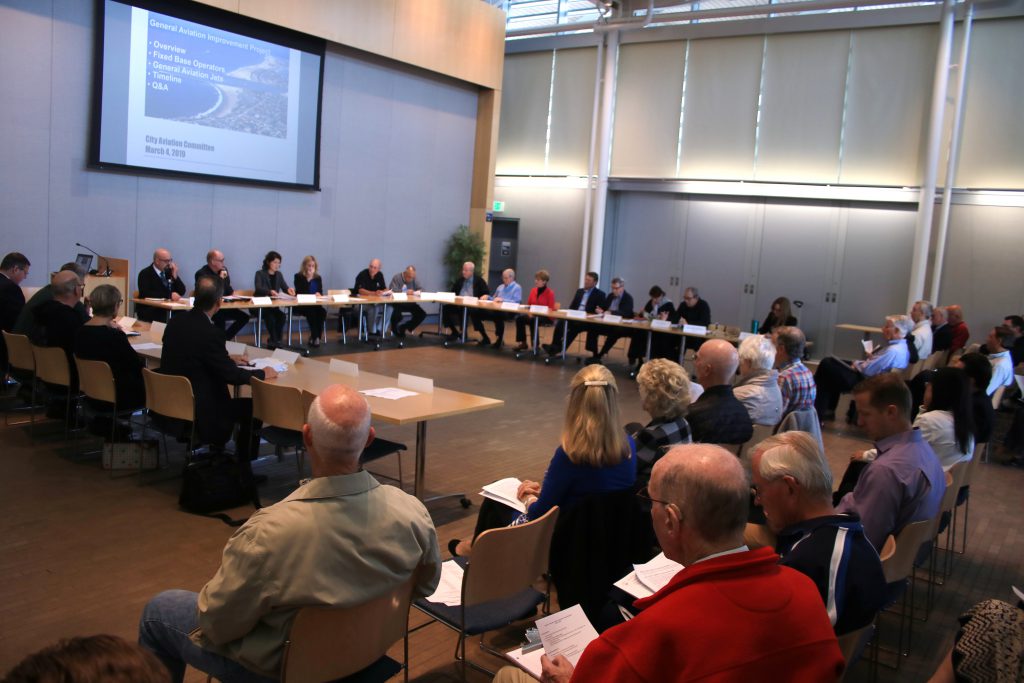
— Photo by Sara Hall ©
Possible changes to John Wayne Airport were discussed at a Newport Beach Aviation Committee meeting this week, raising a number of concerns from residents.
About 50 people crowded into the community room at the Civic Center on Monday for the meeting.
The hot topic of the meeting was the Draft Environmental Impact Report for the proposed General Aviation Improvement Program for JWA and several potential project alternatives.
The committee reluctantly, but unanimously supported project alternative three, and opted to include a number of the concerns raised at the meeting in their recommendation to the City Council.
While the city’s official comments are confined to issues directly related to the EIR at this time, there were several suggestions made by the audience and committee members that were not necessarily addressed in the EIR. Since their motion is only going to City Council as a recommendation, many of those concerns were included “so the City Council knows how this committee and how the public feel about this situation,” Aviation Committee chair and City Councilman Jeff Herdman explained.
“There isn’t a perfect solution, it’s a hard situation, but alternative three is the best we can do,” committee member Melinda Seely noted.
Public speakers at the meeting favored no project at all, or, if they absolutely had to choose, alternative three.
Several residents commented that there are still many unanswered questions and unresolved issues, like security, international travel, curfew, night operations, environmental impact, noise, and more.
The airport is owned and operated by the county, Edwards pointed out. A few also questioned the motives of why the county wanted to do this at all, citing financial reasons, and that it’s not what is best for the community.
Committee member Tim Stoaks, as well as a few public speakers, also raised concerns about a possible loophole for the “uber in the air” or “on demand” concept of potentially allowing unscheduled flights.
Tom Edwards, who presented the program EIR and project alternatives, added that there were still questions about the location and size of the new GA terminal and who would operate the FBO.
In his presentation, Edwards emphasized this is about general, not commercial, aviation.
A main concern of speakers was noise.
Longtime resident and Still Protecting Our Newport member Nancy Alston commented that the general aviation jets registered an average 82.3 on the noise monitors near her home, while a Delta commercial plane only registered at 79.7.
“If any of you are under this mistaken belief that those private jets are quieter, I want to disillusion you of that notion,” Alston said.

— NB Indy file photo by Lawrence Sherwin ©
Residents also raised concerns that building the full-service Fixed Base Operator facilities will attract planes from the big corporations and encourage high intensity activity.
“Once you build it, they will come,” Mel Beale commented.
Full-service Fixed Base Operator, is a commercial business that provides a wide range of aeronautical and support services to general aviation pilots, flight crews and passengers. There are currently two, full-service FBOs with conventional, community hangars at JWA, located on the east side of the airfield.
The FBOs are the “major construction pieces” in the program, Edwards noted.
Currently, approximately 49.75 General Aviation jet departures per day.
A “no project” option would keep the existing FBOs and would not include correction of existing non-standard design. In 2026, it would increase to an estimated 52.46 GA jet departures per day.
“That’s if the airport packed up its bags (and did nothing), we’d still have an increase to about 53 GA per day,” Edwards said.
The proposed project includes two full-service FBOs (northwest and northeast). It would also include a new GA/GAF terminal. It also includes correcting four existing, non-standard design features. Under this plan, by 2026, there would be an estimated 55.34 GA jet departures per day.
The first alternative plans for three full-service FBOs (northwest, northeast, and southeast). It also includes the new general aviation terminal and correction of the non-standard design features. Under this plan, by 2026, there would be an estimated 56.71 GA jet departures per day.
Alternative two includes two full-service FBOs (northeast and southeast). Again, it includes the new general aviation terminal and correction of the non-standard design features. Under this plan, by 2026, there would be an estimated 54.65 GA jet departures per day.
The third alternative, the option the committee ultimately recommended (along with their continued concerns) would maintain the existing general aviation facilities and correct to FAA standards, which would include: Widen taxiway object free area/realign vehicle service road, modify existing southeast FBO, and remove 31 tie-down spaces. There would be no new GA terminal. Under this plan the estimate for general aviation jet departures is the lowest, at 49.8 per day by 2026.
“In my opinion, the least impactful would be alternative three,” Edwards said.
Depending on which project is adopted, the project itself could take nine years or more, Edwards said. Improvements would be done in phases, he added.
The Orange County Board of Supervisors ultimately decides, Edwards noted. They are expected to consider the program draft EIR on April 23.
Committee members and residents urged others to write, call and show up at the Supervisors meeting to voice their concerns. Several speakers commented that it felt like the county was not listening or considering them.
“It seems like we give and they take and we’re left with the impacts,” Stoaks pointed out, getting some applause from the audience. “When does that stop?”




